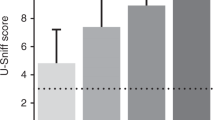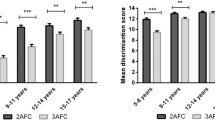Abstract
The aim of our study was to examine odor detection thresholds and odor identification in autistic subjects. Thirty-five patients with Asperger’s syndrome and high functioning autism (mean age 10.8 ± 3.6 years; 31 boys) were compared with 35 healthy control subjects (mean age 10.4 ± 2.4 years; 28 boys). There were no significant differences between groups with regard to mean age (p = 0.598) and gender proportion (p = 0.324). Olfactory testing used the Sniffin’ Sticks test (threshold and identification parts only). Participants with Asperger’s syndrome and high functioning autism, in comparison with healthy controls, were significantly impaired relative to odor detection thresholds (6.3 ± 3.1 vs. 7.9 ± 2.0; p = 0.025). Autistic participants were significantly better in correctly identifying the odor of an orange (94 vs. 63%; p < 0.05) and significantly worse at correctly identifying the odor of cloves (40 vs. 74%; p < 0.05). With regard to identification of fourteen other substances, there were no significant differences. There was no significant difference between autistic and control subjects on the total score of olfactory identification (p = 0.799). Odor identification ability (as expressed by this total score) correlated significantly with age in the control group (p = 0.049), but not in the autism group (p = 0.103). We found impaired odor detection and almost normal odor identification in children with autism. Implications for further research are discussed.
Similar content being viewed by others
References
Mesholam RI, Moberg PJ, Mahr RN, Doty RL (1998) Olfaction in neurodegenerative disease. A meta-analysis of olfactory functioning in Alzheimer’s and Parkinson’s diseases. Arch Neurol 55:84–90
Hawkes C (2003) Olfaction in neurodegenerative disorder. Mov Disord 18:364–372
Brewer WJ, Castle D, Ch Pantelis (2006) Olfaction and the brain. Cambridge University Press, New York
Suchowersky O, Reich S, Perlmutter J, Zesiewicz T, Gronseth G, Weiner WJ (2006) Practice parameter: diagnosis and prognosis of new onset Parkinson disease (an-evidence based review). Neurology 66:968–975
Moberg PJ, Agrin R, Gur RE, Gur RC, Turetsky BI, Doty RL (1999) Olfactory dysfunction in schizophrenia: a qualitative and quantitative review. Neuropsychopharmacol 21:325–340
Leekam SR, Nieto C, Libby SJ, Wing L, Gould J (2007) Describing the sensory abnormalities of children and adults with autism. J Autism Dev Disord 37:894–910
Kientz MA, Dunn W (1997) A comparison of the performance of children with and without autism on the sensory profile. Am J Occup Ther 51:530–537
Rogers SJ, Hepburn S, Wehner E (2003) Parent reports of sensory symptoms in toddlers with autism and those with other developmental disorders. J Autism Dev Disord 33:631–642
Baranek GT, David FJ, Poe MD, Stone WL, Watson LR (2006) Sensory experiences questionnaire: discriminating sensory features in young children with autism, developmental delays, and typical development. J Child Psychol Psychiatry 47:591–601
Kern JK, Garver CR, Trivedi MH, Grannemann BD, Andrews AA, Savla JS, Johnson DG, Mehta JA, Schroeder JL (2006) The pattern of sensory processing abnormalities in autism. Autism 10:480–494
Watling RL, Deitz J, White O (2001) Comparison of sensory profile scores of young children with and without autism spectrum disorder. Am J Occup Ther 55:416–423
Lane AE, Young RL, Baker AE, Angley MT (2010) Sensory processing subtypes in autism: association with adaptive behavior. J Autism Dev Disord 40:112–122
Lane AE, Dennis SJ, Geraghty ME (2010) Brief report: Further evidence of sensory subtypes in autism. J Autism Dev Disord. doi:10.1007/s10803-010-1103-y
Frith U (1992) Autism: explaining the Enigma. Blackwell, Oxford
Hitoglou M, Ververi A, Antoniadis A, Zafeiriou DI (2010) Childhood autism and auditory system abnormalities. Pediatr Neurol 42:309–314
Khalfa S, Bruneau N, Roge B, Georgieff N, Veuillet E, Adrien JL, Barthelemy C, Collet L (2004) Increased perception of loudness in autism. Hear Res 198:87–92
Tharpe AM, Bess FH, Sladen DP, Schissel H, Couch S, Schery T (2006) Auditory characteristics of children with autism. Ear Hear 27:430–441
Jones CRG, Happe F, Baird G, Simonoff E, Marsden AJS, Tregay J, Phillips R, Goswami U, Thomson JM, Charman T (2009) Auditory discrimination and auditory sensory behaviours in autism spectrum disorders. Neuropsychologia 47:2850–2858
Bennetto L, Kuschner ES, Hyman SL (2007) Olfaction and taste processing in autism. Biol Psychiatry 62:1015–1021
Volkmar FR, Paul R, Klin A, Cohen D (eds) (2005) Handbook of Autism and pervasive developmental disorders, 3rd edn. John Wiley & Sons, New York
Wiggins LD, Robins DL, Bakeman R, Adamson LB (2009) Brief report: sensory abnormalities as distinguishing symptoms of autism spectrum disorders in young children. J Autism Dev Disord 39:1087–1091
Suzuki Y, Critchley HD, Rowe A, Howlin P, McMurphy DGM (2003) Impaired olfactory identification in Asperger′s syndrome. J Neuropsychiatry Clin Neurosci 15:105–107
Doty RL, Shaman P, Dann M (1984) Development of the University of Pennsylvania Smell Identification Test: a standardized microencapsulated test of olfactory function. Physiol Behav 32:489–502
Brewer WJ, Brereton A, Tonge BJ (2008) Dissociation of age and ability on a visual analogue of the University of Pennsylvania Smell Identification Test in children with autism. Res Autism Spectr Disord 2:612–620
May T, Brewer WJ, Rinehart NJ, Enticott PG, Brereton AV, Tonge BJ (2010) Differential olfactory identification in children with autism and Asperger’s disorder: a comparative and longitudinal study. J Autism Dev Disord. doi:10.1007/s10803-010-1101-0
Hrdlicka M, Vodicka J, Havlovicova M, Urbanek T, Blatny M, Dudova I (2011) Brief report: significant differences in perceived odor pleasantness found in children with ASD. J Autism Dev Disord 41:524–527
Lord C, Rutter M, LeCouteur A (1994) Autism diagnostic interview-revised: a revised version of a diagnostic interview for caregivers of individuals with possible pervasive developmental disorders. J Autism Dev Disord 24:659–685
Schopler E, Reichler RJ, DeVellis RF, Daly K (1980) Toward objective classification of childhood autism: childhood autism rating scale (CARS). J Autism Dev Disord 10:91–103
Williams J, Scott F, Stott C, Allison C, Bolton P, Baron-Cohen S et al (2005) The CAST (Childhood Asperger Syndrome Test). Autism 9:45–68
World Health Organization (1992) International classification of diseases, 10th edn. WHO, Geneva
Hummel T, Sekinger B, Wolf SR, Pauli E, Kobal G (1997) ‘Sniffin’ Sticks’: olfactory performance assessed by the combined testing of odor identification, odor discrimination and olfactory threshold. Chem Senses 22:39–52
Kobal G, Klimek L, Wolfensberger M, Gudziol H, Temmel A, Owen CM et al (2000) Multicenter investigation of 1, 036 subjects using a standardized method for the assessment of olfactory function combining tests of odor identification, odor discrimination, and olfactory thresholds. Eur Arch Otorhinolaryngol 257:205–211
Vodicka J, Pellant A, Chrobok V (2007) Screening of olfactory function using odourized markers. Rhinology 45:164–168
Moye LA (2003) Multiple analyses in clinical trials. Springer, New York
Doty RL (2003) Handbook of olfaction and gustation, 2nd edn. Marcel Dekker, New York
Naik BS, Shetty N, Maben EVS (2010) Drug-induced taste disorders. Eur J Intern Med 21:240–243
Passali GC, Ralli M, Galli J, Calo L, Paludetti G (2008) How relevant is the impairment of smell for the quality of life in allergic rhinitis? Curr Opin Allergy Clin Immunol 8:238–242
Guilemany JM, Garcia-Pinero A, Alobid I, Cardelus S, Centellas S, Bartra J, Valero A, Picado C, Mullol J (2009) Persistent allergic rhinitis has a moderate impact on the sense of smell, depending on both nasal congestion and inflammation. Laryngoscope 119:233–238
Fokkens WJ, Lund VJ, Mullol J et al (2007) European position paper on nasal polyps. Rhinology 45:1–139
Acknowledgments
Supported by the Ministry of Education, Youth and Sports, Czech Republic (research grant MSM 0021620849), the Ministry of Health, Czech Republic (research grants MZ0FNM2005 and 1A-8667/4), and by the Institute of Psychology, Academy of Science, Czech Republic (research plan AV0Z70250504). We thank the Autism Research Center (University of Cambridge, UK) for use of the CAST screening tool that was used in our research.
Conflict of interest
None.
Author information
Authors and Affiliations
Corresponding author
Rights and permissions
About this article
Cite this article
Dudova, I., Vodicka, J., Havlovicova, M. et al. Odor detection threshold, but not odor identification, is impaired in children with autism. Eur Child Adolesc Psychiatry 20, 333–340 (2011). https://doi.org/10.1007/s00787-011-0177-1
Received:
Accepted:
Published:
Issue Date:
DOI: https://doi.org/10.1007/s00787-011-0177-1




